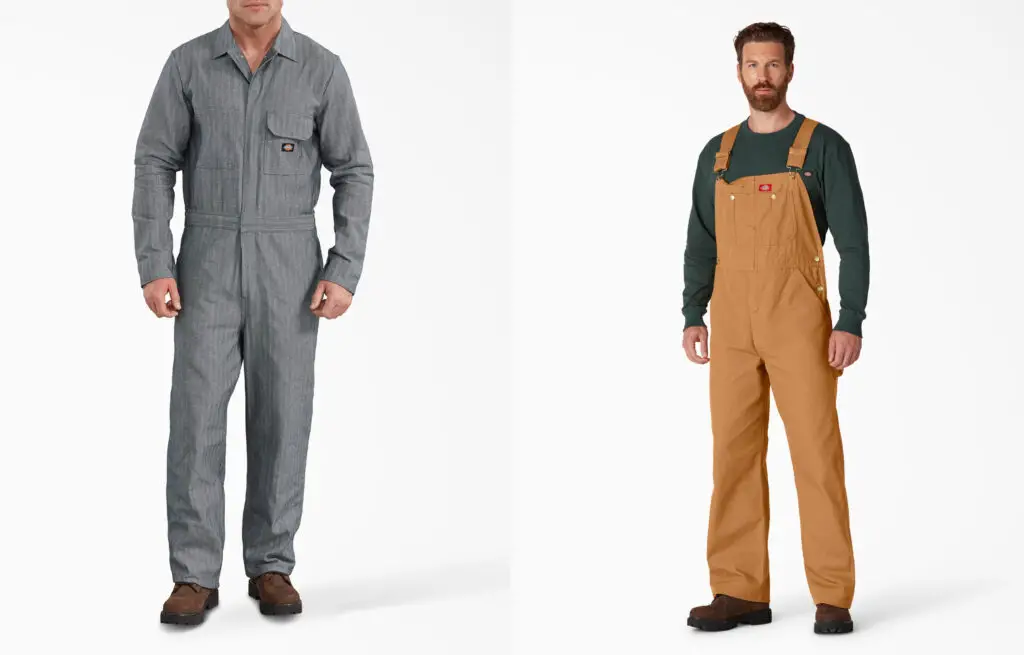The difference between the coveralls and overalls is that coveralls cover your entire body whereas overalls cover your lower part and have bibs and braces in the upper part.
Overalls are made up of denim, cotton or linen fabrics and are designed with loose cross straps and bibs worn over the other clothes. Whereas, coveralls are made up of cotton/polyester blends and are characterised as a loose-fitting one-piece garment with buttons, zips, Velcro, or snaps in the middle.
Overalls are worn by manual labourers who need a high level of protection while coveralls, on the other hand, are worn by workers who require shoulder-to-ankle protection.
Regardless of the differences, the objective of wearing coveralls and overalls is to protect oneself from hazardous, dense, and strenuous working situations.

Why Is Protective Clothing Important?
Remember when we all first get our lab coat, what do you think the reason is? Yes, it is for protecting ourselves from the chemicals in the lab while working on the experiments.
Similarly, protective clothing worn on construction sites serves the same purpose, the purpose to shield workers from the dangers they were subjected to while working with tools and construction materials.
Working on a construction site is both challenging and dangerous since workers are exposed to hazards unique to the construction industry.
They work hundreds of feet above ground, where acids, radiant heat, sparks, bare flames, and heavy things like bricks and beams pose a threat.
As a result, protecting oneself from hazardous materials and flames is almost as fundamental as being visible to one’s co-workers when working on a construction site.
At such locations, protective clothing is almost as necessary as any other safety equipment. The most common PPE (Personal Protective Equipment) worn by construction workers and experts are overalls and coveralls and are ubiquitous at well administered construction sites.
Before going into the difference between overalls and coveralls, let’s have a common understanding on what coveralls and overalls are.
What are Coveralls?
Historically, those who worked in coal mining and those who operated coal-powered boilers wore coveralls. They had to climb into the firebox of a steam train to shovel coal in, therefore wearing a garment with no gap in the middle aided in preventing soot from entering the lower half of the clothes.
It also eliminated waistline snagging while manoeuvring inside a confined location, as well as coat tail catches when exiting backwards.
In modern times, however, this garment can be worn alone or over clothes to protect both the person and the clothes.

It is now essential for different construction and industrial sectors serving the purpose of protecting the body from the ankles to the wrists.
They meet the basic essentials of protection, warmth, and breathability so that the workers are well protected from any form of harm resulting from fire/flame, water and other hazardous materials, it acts as a resistance to these as well.
Coveralls are imperative for workers across a range of varied industries, including agriculture, petrochemical, food, mechanical, engineering, medical and emergency response, fire and safety, and other labour-intensive industries.
So, according to the purpose it serves coveralls are designed as a loose one-piece outer garment that covers your entire body and protects them from hazardous working conditions.
They have both long and short sleeves and are used according to the convenience of the user and the characteristics of the job he’s doing. It is advised to wear the coveralls above the other garments you’re wearing, having this base layer will avoid any unwanted chafing and provide comfort.
Coveralls are made from a range of different materials; however, it is often made up of cotton and polyester blends resulting in breathable and durable protective clothing that act as a protective barrier against dangerous contaminants.
The coveralls are fastened up usually in the front either using buttons, zips, velcro or snaps. One of the main advantages of this clothing is that it comes with multiple pockets and tool loops which makes the workers’ job handy.
There nine types of coveralls which are commonly used by the workers, these include basic and disposable coveralls, flame-resistant, insulated, arc-resistant waterproof, hi-vis, mechanic jumpsuit and women’s coveralls.
What are Overalls?
Historically, Overalls were basically used by farmers and railway workers in the US. However, these garments gained popularity in the 60s and 70s in the fashion industries and boomed the industry with different colours and designs which deviated from the traditional denims.
As the history of overalls goes in that trajectory, here in this writing I’ll be talking about its use for industrial workers as a protective clothing.
The modern usage of this clothing is mainly designed for farmers, painters, factory workers, train locomotive engineers, carpenters and other labourers.

Overalls are ideal to wear because they suit well on these wearers’ frames unlike the coverall as they aren’t required to be tied to a belt or to be held up using suspenders.
Overalls are made from denim, tough cotton or linen fabrics purposefully designed particularly for safety measures while working in the construction and industrial sites.
Supported with cross-straps, overalls are loose fitted jeans worn along with half or full sleeves and are worn over vests and trousers.
The main purpose of using overalls is to protect themselves from coldness, heat, splashes, sparks, flames, flying debris and other hazardous conditions they were exposed to.
Apart from its characterisation as a protective clothing that provides the warmth, visibility, water repellency, fire proof coatings, the overall is also used as a uniform.
We all are familiar with wearing uniforms, what purpose do they have? Identification. It is exactly the same here, overalls are designed and coloured in different varieties and is used to recognise which sub departments the wearer belongs to.
It is the wearer’s level of exposure to the hazardous conditions that decide which type of overall to be used.
The different types of overalls include work overalls along with bib and brace, waterproof and flame retardant overalls, hi vis overalls for high visibility used by workers on the roads, rails, and near cranes, then the padded overalls used during cold weather.
Wearing this bib & brace workwear were made mainstream by safety manufacturers, and was popularised it as a protective clothing equipment that offer no restriction in upper-body movement which is so perfect for hands on works.
It is very comfortable to wear as it helps the workers to carry out their duties better and safely. But in contrast they offer no offer no protection to the upper body which is one of its disadvantages while using it in more hazardous situations in work sites.
Main Features of Coveralls and Overalls
| Coveralls | Overalls |
| A loose one-piece outer garment | Loose cross straps and bibs |
| Also known as boilersuit | Also known as dungarees |
| Made from cotton and polyester | Made from denim, cotton or linen fabrics |
| Different types: basic and disposable coveralls, flame-resistant, insulated, arc-resistant waterproof, hi-vis, mechanic jumpsuit and women’s coveralls | Work overalls along with bib and brace, waterproof and flame retardant overalls, hi vis overalls, padded overalls |
| Have both long and short sleeves | Do not have sleeves, but have bibs and braces |
| Protect and cover your entire body | Do not cover your upper part |
| Worn over other dresses | A shirt or t-shirt is worn first, then overall is worn over other dresses. |
| Have multiple pockets and tool loops | Less pockets and tool loops |
| Buttons, zips, Velcro, or snaps in the chest area | Bibs along with pocket in the chest area |
| Worn by workers who need shoulder to ankle protection | Worn by manual workers who need heavy protection |
| Chemical workers, electricians, factory employees, landscapers, machine operators, maintenance engineers, and mechanics | Farmers, painters, factory workers, railroad locomotive engineers, carpenters |
Difference between coveralls and overalls
According to general criteria, the one distinction between coveralls and overalls is the regional difference — the British versus the Americans. Let me point you that there are more distinctions in physical appearance and usage than just regional disparities.
Overalls are worn in environments where the person performs manual labour and requires a high level of protection. Coveralls, on the other hand, are worn by workers who require shoulder-to-ankle protection in congested and intensive work conditions.
Chemical workers, electricians, factory employees, landscapers, machine operators, maintenance engineers, and mechanics, among others, use coveralls. Whereas, farmers, painters, factory workers, railroad locomotive engineers, carpenters, and so on are the principal users of overalls.
The next difference is that overalls have loose cross straps and bibs worn over the other types of clothing. Coveralls are loose-fitting one-piece garments with buttons, zips, Velcro, or snaps in the middle to connect the two sides and are also worn over the ordinary dress.
Coveralls will protect your entire body, while overalls do not protect your upper part. Denim, tough cotton, or linen fabrics are commonly used for overalls, whereas cotton and polyester blends are used for coveralls.
These are the primary differences between coveralls and overalls used as personal protective equipment in the workplace.
Whatever peculiarities it may have, it is utilized in general for one purpose: to protect workers from hazardous working situations. The distinctions occur between them only when it comes to their usage, field of working and physical appearances.
To conclude
You now have a better understanding of the differences between coveralls and overalls, as well as the general purpose of both types of apparel.
The reason you should know the differences between these two is that knowing their differences will assist you to choose the right PPE for the task.
Whatever you call it coveralls or overalls, always remember to select PPE according to the degree of your exposure to dangerous substances.
I believe through this writing you have learned the importance of having coveralls and overalls in your workplaces to protect yourself from hazardous working circumstances.







